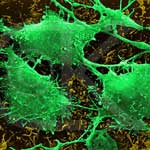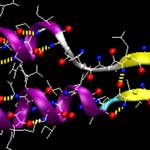Showing Spotlights 1937 - 1944 of 2779 in category All (newest first):
 A couple of years ago we reported on applications of nanotechnology-based processes to the restoration and preservation of priceless artwork. Researchers have shown that nanodispersions of solids, micelle solutions, gels and microemulsions offer new reliable ways to restore and preserve works of art by merging together the main features and properties of soft-matter and hard-matter systems, allowing the synthesis of systems specifically tailored for the works of art to fight the deterioration processes which threaten many priceless masterpieces. Researchers at the University of Florence, who have been leading efforts to apply nanoparticle-based cleaning agents for artwork, have now further developed their work by exploring the design of novel systems containing low amounts of volatile oils as low-impact cleaning tools for the removal of aged polymeric coatings from the surface of paintings.
A couple of years ago we reported on applications of nanotechnology-based processes to the restoration and preservation of priceless artwork. Researchers have shown that nanodispersions of solids, micelle solutions, gels and microemulsions offer new reliable ways to restore and preserve works of art by merging together the main features and properties of soft-matter and hard-matter systems, allowing the synthesis of systems specifically tailored for the works of art to fight the deterioration processes which threaten many priceless masterpieces. Researchers at the University of Florence, who have been leading efforts to apply nanoparticle-based cleaning agents for artwork, have now further developed their work by exploring the design of novel systems containing low amounts of volatile oils as low-impact cleaning tools for the removal of aged polymeric coatings from the surface of paintings.
Oct 26th, 2009
 Eric Drexler replies to yesterday's Spotlight on Feynman and nanotechnology. 'Neither Feynman nor the vision of molecular manufacturing created the fields that have joined to become 'nanotechnology', nor did they provide the concrete scientific opportunities and technological applications that drive it forward. However, what set nanotechnology on its path to prominence was not a sudden realization by the public and politicians that new molecules and nanostructures have a host of applications in materials, sensors, and so on. It was, and is, the promise of revolutionary advances in atomically precise manufacturing, advances that will build on the technology platform now emerging from nanotechnology research.'
Eric Drexler replies to yesterday's Spotlight on Feynman and nanotechnology. 'Neither Feynman nor the vision of molecular manufacturing created the fields that have joined to become 'nanotechnology', nor did they provide the concrete scientific opportunities and technological applications that drive it forward. However, what set nanotechnology on its path to prominence was not a sudden realization by the public and politicians that new molecules and nanostructures have a host of applications in materials, sensors, and so on. It was, and is, the promise of revolutionary advances in atomically precise manufacturing, advances that will build on the technology platform now emerging from nanotechnology research.'
Oct 23rd, 2009
 In December 2009 we will receive a series of reminders of the fiftieth anniversary of Richard Feynman's noted talk, 'There's Plenty of Room at the Bottom'. As commentaries appear in scientific journals, the nanotechnology community will have multiple opportunities to think about the role of Feynman's talk in the history of nanotechnology. Feynman's 1959 talk has been widely hailed as the origin of nanotechnology. It is a comprehensive vision of controlling matter at the nanoscale, including controlling individual atoms. However, at this point, there are two very different views of the role of Feynman's talk in the history of nanotechnology: 1. Everybody knows that Feynman's 'Plenty of Room' is the origin of nanotech. 2. The emergence of nanotech had little to do with Feynman's talk.
In December 2009 we will receive a series of reminders of the fiftieth anniversary of Richard Feynman's noted talk, 'There's Plenty of Room at the Bottom'. As commentaries appear in scientific journals, the nanotechnology community will have multiple opportunities to think about the role of Feynman's talk in the history of nanotechnology. Feynman's 1959 talk has been widely hailed as the origin of nanotechnology. It is a comprehensive vision of controlling matter at the nanoscale, including controlling individual atoms. However, at this point, there are two very different views of the role of Feynman's talk in the history of nanotechnology: 1. Everybody knows that Feynman's 'Plenty of Room' is the origin of nanotech. 2. The emergence of nanotech had little to do with Feynman's talk.
Oct 22nd, 2009
 Nanotechnologies are opening vast new opportunities for scientists, engineers and entrepreneurs to participate in solving some of the major problems facing mankind today. But the road from idea to commercially viable product or process is long. Especially when it comes to nanotech innovations, the research and development phase tends to be relatively lengthy. To help potential nanotechnology start-up founders with shaping their plans, Nanowerk, the leading nanotechnology information service, and Nanostart, the world's leading nanotechnology venture capital company, have teamed up to provide this useful guide which particularly addresses the funding aspects of nanotechnology start-ups, along with answers to some of the most commonly asked questions.
Nanotechnologies are opening vast new opportunities for scientists, engineers and entrepreneurs to participate in solving some of the major problems facing mankind today. But the road from idea to commercially viable product or process is long. Especially when it comes to nanotech innovations, the research and development phase tends to be relatively lengthy. To help potential nanotechnology start-up founders with shaping their plans, Nanowerk, the leading nanotechnology information service, and Nanostart, the world's leading nanotechnology venture capital company, have teamed up to provide this useful guide which particularly addresses the funding aspects of nanotechnology start-ups, along with answers to some of the most commonly asked questions.
Oct 21st, 2009
 Detection at the earliest stage provides the greatest chance of survival for cancer patients. Cancer has a logarithmic growth rate and doctors typically don't see 80% of the life of a tumor. Detection can be done using a number of techniques including standard immunoassays and biopsies. Nanotechnology offers new detection approaches such as targeted contrast agents, nanoscale cantilevers coated with antibodies against tumor markers, and magnetic nanoparticles coated with DNA labeling. But the problem is daunting because there are over 50 common types of cancer and in practice it is difficult to ask people to come to the clinic on a regular basis for cancer screening. Researchers have now proposed a new method for the detection of cancer cells based on measurement of the physical adhesion of silica beads to malignant versus normal cells cultured from human cervix.
Detection at the earliest stage provides the greatest chance of survival for cancer patients. Cancer has a logarithmic growth rate and doctors typically don't see 80% of the life of a tumor. Detection can be done using a number of techniques including standard immunoassays and biopsies. Nanotechnology offers new detection approaches such as targeted contrast agents, nanoscale cantilevers coated with antibodies against tumor markers, and magnetic nanoparticles coated with DNA labeling. But the problem is daunting because there are over 50 common types of cancer and in practice it is difficult to ask people to come to the clinic on a regular basis for cancer screening. Researchers have now proposed a new method for the detection of cancer cells based on measurement of the physical adhesion of silica beads to malignant versus normal cells cultured from human cervix.
Oct 16th, 2009
 Spider silk is a fascinating biopolymer that is stronger than steel and more elastic than rubber. Most of the world's 40,000 species of spiders produce a silken thread that possesses a unique combination of mechanical properties: strength (its tensile strength is about five times as strong a steel of the same density), extensibility (up to 30%) and toughness (its ability to absorb a large amount of energy without breaking). Researchers are experimenting with spider silk to design better adhesives; advanced materials that are both stretchy and strong; and to get clues for protein engineering. Yet the impressive performance of spider silk is not limited solely to tensile mechanics. Researchers have now shown that silk also exhibits powerful cyclic contractions that are precisely controlled by changes in humidity, allowing it to act as a high performance mimic of biological muscles.
Spider silk is a fascinating biopolymer that is stronger than steel and more elastic than rubber. Most of the world's 40,000 species of spiders produce a silken thread that possesses a unique combination of mechanical properties: strength (its tensile strength is about five times as strong a steel of the same density), extensibility (up to 30%) and toughness (its ability to absorb a large amount of energy without breaking). Researchers are experimenting with spider silk to design better adhesives; advanced materials that are both stretchy and strong; and to get clues for protein engineering. Yet the impressive performance of spider silk is not limited solely to tensile mechanics. Researchers have now shown that silk also exhibits powerful cyclic contractions that are precisely controlled by changes in humidity, allowing it to act as a high performance mimic of biological muscles.
Oct 14th, 2009
 In animal cells, the well known cytoskeletal proteins actin microfilaments and microtubules are accompanied by a third filament system that in humans consist of a family of more than 70 proteins. These fibrous proteins are absent from both plants and fungi, and have been linked to serious human diseases including cancer, muscle dystrophies and rapid aging disease. Their name, intermediate filament, was coined back in 1978 because their diameters - about 10 nanometers - appeared to be intermediate in size between those of microtubules and microfilaments. Their atomistic-level molecular structure remains elusive, and as a consequence, the understanding of the biological role in physiological and disease states is still in its infancy. Researchers now report a breakthrough in explaining the structural and mechanistic origin of the unique mechanical properties of intermediate filaments. By combining atomistic and molecular modeling with experimental studies, the researchers report a multi-scale analysis that showed that the mechanical properties of intermediate filaments are controlled by their characteristic hierarchical makeup.
In animal cells, the well known cytoskeletal proteins actin microfilaments and microtubules are accompanied by a third filament system that in humans consist of a family of more than 70 proteins. These fibrous proteins are absent from both plants and fungi, and have been linked to serious human diseases including cancer, muscle dystrophies and rapid aging disease. Their name, intermediate filament, was coined back in 1978 because their diameters - about 10 nanometers - appeared to be intermediate in size between those of microtubules and microfilaments. Their atomistic-level molecular structure remains elusive, and as a consequence, the understanding of the biological role in physiological and disease states is still in its infancy. Researchers now report a breakthrough in explaining the structural and mechanistic origin of the unique mechanical properties of intermediate filaments. By combining atomistic and molecular modeling with experimental studies, the researchers report a multi-scale analysis that showed that the mechanical properties of intermediate filaments are controlled by their characteristic hierarchical makeup.
Oct 13th, 2009
 Surface-plasmon resonance is a quantum-electromagnetic phenomenon arising from the interaction of light with free electrons at the planar interface of a metal and a (nonconducting) dielectric material. This resonance arises when the energy carried by photons in the dielectric material is transferred to collective excitations (called plasmons) of free electrons in the metal at that interface. As the free electrons in the metal are coupled to the photons in the polarizable dielectric material, the quantum is called a surface plasmon-polariton (SPP). Typically, a SPP wave is launched on a metal-dielectric interface at one particular frequency. That wave has a certain polarization state. Researchers have now shown theoretically and experimentally that by modifying the dielectric material, novel surface-plasmon-polariton wave behavior can be created with the result that the same interface can independently guide more than one SPP wave.
Surface-plasmon resonance is a quantum-electromagnetic phenomenon arising from the interaction of light with free electrons at the planar interface of a metal and a (nonconducting) dielectric material. This resonance arises when the energy carried by photons in the dielectric material is transferred to collective excitations (called plasmons) of free electrons in the metal at that interface. As the free electrons in the metal are coupled to the photons in the polarizable dielectric material, the quantum is called a surface plasmon-polariton (SPP). Typically, a SPP wave is launched on a metal-dielectric interface at one particular frequency. That wave has a certain polarization state. Researchers have now shown theoretically and experimentally that by modifying the dielectric material, novel surface-plasmon-polariton wave behavior can be created with the result that the same interface can independently guide more than one SPP wave.
Oct 12th, 2009
 A couple of years ago we reported on applications of nanotechnology-based processes to the restoration and preservation of priceless artwork. Researchers have shown that nanodispersions of solids, micelle solutions, gels and microemulsions offer new reliable ways to restore and preserve works of art by merging together the main features and properties of soft-matter and hard-matter systems, allowing the synthesis of systems specifically tailored for the works of art to fight the deterioration processes which threaten many priceless masterpieces. Researchers at the University of Florence, who have been leading efforts to apply nanoparticle-based cleaning agents for artwork, have now further developed their work by exploring the design of novel systems containing low amounts of volatile oils as low-impact cleaning tools for the removal of aged polymeric coatings from the surface of paintings.
A couple of years ago we reported on applications of nanotechnology-based processes to the restoration and preservation of priceless artwork. Researchers have shown that nanodispersions of solids, micelle solutions, gels and microemulsions offer new reliable ways to restore and preserve works of art by merging together the main features and properties of soft-matter and hard-matter systems, allowing the synthesis of systems specifically tailored for the works of art to fight the deterioration processes which threaten many priceless masterpieces. Researchers at the University of Florence, who have been leading efforts to apply nanoparticle-based cleaning agents for artwork, have now further developed their work by exploring the design of novel systems containing low amounts of volatile oils as low-impact cleaning tools for the removal of aged polymeric coatings from the surface of paintings.
 Subscribe to our Nanotechnology Spotlight feed
Subscribe to our Nanotechnology Spotlight feed





